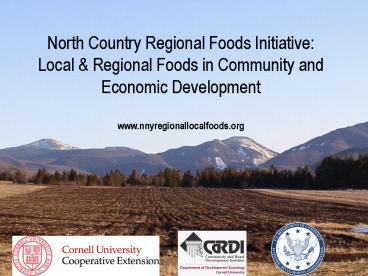North Country Regional Foods Initiative - PowerPoint PPT Presentation
1 / 15
Title:
North Country Regional Foods Initiative
Description:
Growing interest in local and regional food enterprises in Northern NY ... Returning fallow land to production/protecting water ... – PowerPoint PPT presentation
Number of Views:24
Avg rating:3.0/5.0
Title: North Country Regional Foods Initiative
1
North Country Regional Foods InitiativeLocal
Regional Foods in Community and Economic
Developmentwww.nnyregionallocalfoods.org
2
NCRFI Starting Points
- Growing interest in local and regional food
enterprises in Northern NY - CCE Associations providing programmatic support
for local/regional food businesses and consumers - CaRDIs approach to Community and Economic
Development assumes they go hand in hand - EDA University Center funding
3
NCRFI Objectives
- Promote community and economic development in NNY
through research-based support for local/regional
foods initiatives - Assessment of local/regional food impacts in NNY
- Development of regional community
- Outreach and training
- Regionally coordinated activities
- Build on the NCRFI to promote regional community
and economic development more generally.
4
Why Regional?
- Similar goals for future and similar activities
designed to achieve those goals - Local and Regional Food Enterprises
Adirondack-North Country industry clusters - Different strengths (assets) and weaknesses
(needs) that can be maximized and minimized,
respectively - Increasingly limited resources can be maximized
through regional collaboration
5
What are local/regional food initiatives?
- Production and Consumption
6
Examples of agricultural planning priorities
activities in NNY
- County
- Marketing and Enterprise Development, Essex
County Farmland Protection Plan. - Actively seek and develop new opportunities to
expand markets for local production, and to
expand local production for these markets,
Agricultural and Farmland Protection Plan for
Clinton County. - Agricultural Market Development Initiative,
St. Lawrence County Agricultural Development
Plan.
- Regional
- Adirondack Harvest
- Adirondack North Country Association Agriculture
Strategy Development - Northern NY Ag Development Program
- Come Farm with Us
7
NCRFI Project Components
- Outreach and networking
- Training
- Research
8
Findings - General
- Business decisions tied to personal
goals/interests, not just economics - Contributions to community are intentional
- Experience and educational opportunities and
resources are key - Collaborations highly valuable to enterprises
- Support for local/regional food initiatives is
secondary to primary mission for most
organizations - Optimistic about future but profitability varies
- Owners/Managers offered lots of strategies
9
Findings Some specifics
- Role in the community as a farmer/food business
owner - Support the local economy
- Provide a good product.
- Build trust
- Economic support buy local too
- Developing entrepreneurship
- Advocate for the farmers, trying to help them
stay in business those that believe in the
co-op model. - Community member foremost, active in church,
school, scouts, sports, local boards. Provide
employment, sales tax, property tax, use of local
commodities
10
Findings Some specifics cntd.
- Role in the community as a farmer/food business
owner - Protect local resources
- Maintaining open space
- Protecting resources (seeds and livestock
varieties, land, property rights, etc.) for local
food production. - Returning fallow land to production/protecting
water - Responsible land stewardship (low chemical,
erosion control, soil health) - Maintaining agricultural knowledge base
(practical/sensible passed on from experience) - Support and develop local food systems
- Meet the local communitys need/demand for local
products - Help build model for local production
consumption - Be a role model for other communities.
- Promote public health
- Education
11
Findings Some specifics, cntd.
- Impacts of your organizational work in support of
local/regional food initiatives on the
individuals and communities in the region you
serve - Farm Viability -Having a successful market place
encourages new people to start farming and start
their own business with food and other local ag
products. - Consumer Awareness/Access - Heightened awareness
re benefits of local food and of local food
sources. - Environmental Food does not travel as far from
farm to table (or hoof to mouth). - Health Developing healthy habits
12
Findings Some specifics, cntd.
- Identified future needs
- Consumer education
- More farms to produce local supply
- Infrastructure
- Collaboration
- Additional support groups
- Reform of regulatory issues
- More information on institutional sales
13
Next Steps
- Share report broadly
- Share personally with local officials
community/economic developers - Facilitate development of a regional plan
- Challenges and opportunities
- Pursue further research to fill in knowledge gaps
- Use research to monitor and evaluate progress
14
Additional thoughts
- Internal vs. external strategies
- North Country context
- Feedback from UEDA conference
- What does this have to do with planning?
15
Contributorswww.nnyregionallocalfoods.org/
- CaRDI
- Rod Howe
- (607) 255-2170
- rlh13_at_cornell.edu
- Heidi Mouillesseaux-Kunzman
- (607) 255-0417
- hmm1_at_cornell.edu
- Clinton County
- Amy Ivy
- (518) 561-7450
- adi2_at_cornell.edu
- Essex County
- Anita Deming
- (518) 962-4810
- ald6_at_cornell.edu
- Hamilton County
- Nancy Welch
- (518) 548-6191
- naw5_at_cornell.edu
- Jefferson County
- Rosalind Cook
- (315) 788-8450
- rlc53_at_cornell.edu
- Lewis County
- Dolores DeSalvo
- (315) 376-5270
- dbd6_at_cornell.edu
Northern NY Agriculture Program Dave
Smith rds4_at_cornell.edu St. Lawrence County
Katherine Lang (315) 379-9192 kaa20_at_cornell.edu
Franklin County Bernadette Logozar (518)
483-7403 bel7_at_cornell.edu































